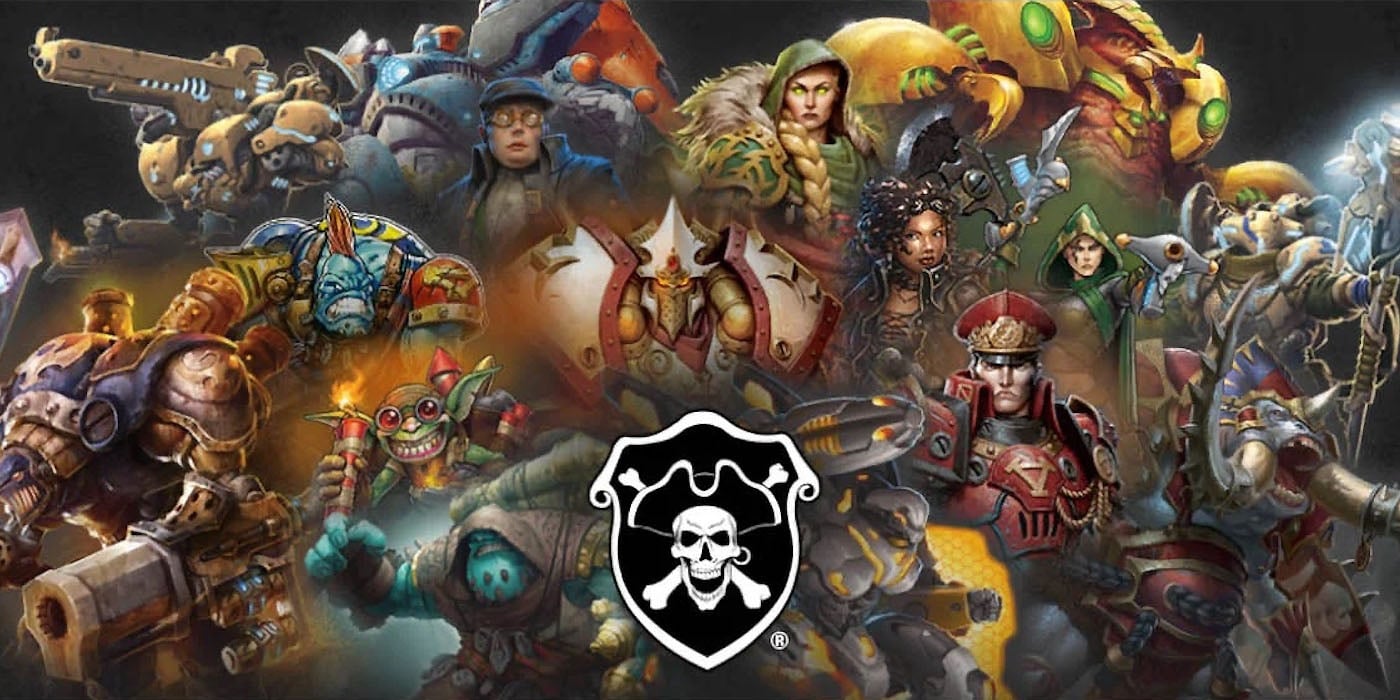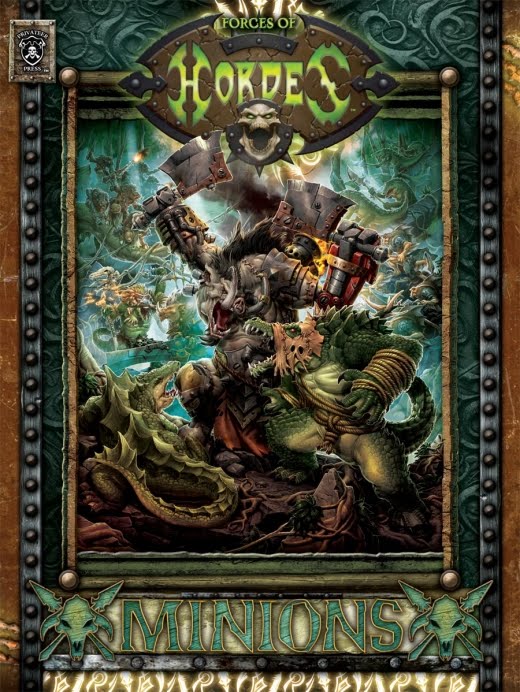Forces of Hordes: Minions


So here it is the final book of a banner year for Privateer Press – Minions. I’ll skip the formalities and just go straight to the nitty gritty; the part I know you’re wanting to hear.
All those folks on the Privateer forums – the ones who analyzed the Minion SKU numbers, found no gaps in the releases, and predicted that all the Minions had already been previewed… I’m afraid they were right. There are no new model surprises waiting for you in the pages of this tome. That being said its still a fine book, and there are plenty of reasons to pick it up. Its still loaded with full color art, lots of great fluff and background, and some very interesting tiers.
The fluff pieces may be the most interesting parts of the book, as they reveal to us a lot of unknown information on the customs, natures, and practices of the Farrow and Gatormen: the two newest playable races for Hordes. The opening piece provides great insight into the minds of the Minion Warlocks, and great care is taken to immerse the reader into the culture of these factions. The story sees a clash between the two races in an effort to highlight the vast differences between the more subtle scheming of the Blindwater Congregation and the tribal aggression of the Thornfall Alliance. The descriptions of the battles are, as always, epic, but the tale also drives home just how big this game’s setting is and just how much weird stuff is left in Imorren that we still know nothing about.
Like the Mercenary book before it, the layout of the Minions book is different from the usual Force books. Its divided into three sections starting with those Minions with no particular affiliations to the existing pacts. This section is prefaced by several pages explaining the nature of the different Minion relationships with the four primary Hordes factions. The Gatormen and Farrow then get their own sections; introduced by even more in-depth discussions of the culture, ambitions, and warfare of these factions. In addition to all this, many of the fluff entries for the models and units have been expanded or updated for this book.
The tiers for the Minion forces offer some very powerful and unique bonuses helping to offset the limited options of the factions in this book. Like the Contracts from the Merc book, Pact benefits must be abandoned if a player wishes to take advantage of the rules for a Warlock’s Tier. Its a tough sell to make you want to give up the Advance Deployment for Farrow offered by the Thornfall Alliance pact, or the free water terrain from the Blindwater Covenant. Especially given the further restrictions on army selection imposed by the Tiers. But I think Privateer did their work well here as there are good reasons to go either way.
Arkadius’ Tier has already been previewed here, and the benefits of it probably outweigh running a straight Thornfall list given Arkadius’ prediliection to beasts over infantry. But I’m willing to try him outside of “Mad Science” just to see if I can get Gudrun the Wanderer to Berserk his way through a whole unit that Arkadius has softened up with a Crippling Grasp.
Lord Carver’s tier list by contrast has to compete with the Thornfall Alliance’s rule that allows Farrow Brigands to Advance Deploy. With the great bonuses he grants to them its hard to part with that extra speed. Fortunately if he follows the same restrictions as Arkadius for list construction, his Tier 1 bonus allows one unit of Brigands, or a Razorback Crew to Advance Deploy and also makes Brigands FA U. Its at Tier 2 where things get really interesting. By including Rorsh and Brine all models/units in the army gain pathfinder on the first turn, but it doesn’t end there. Any light warbeasts included in Rorsh’s battlegroup have their points cost decreased by one point, and any heavies have their cost reduced by two. Given the Lesser Warlock’s fragility, taking him with just Brine is a lot of points to risk, and any extra beasts he takes will be able to benefit from none of Carver’s great battlegroup spells. But they will be able to benefit from Carver’s feat, and there’s nothing to stop you from forcing them to max on that turn for some massive damage output, even if they’ll frenzy later. I’ll definitely have to try running Rorsh with two six point War Hog at least once just for fun. Moving on, Tier 3 actually reduces the cost of Brigand units by one, making it really tempting to run 3 min units of them. Finally if you can squeeze three warbeasts into Carver’s Battlegroup, Tier 4 will let you give them an Advance Move. A lot of really great benefits here for sure, but in addition to the loss of Brigands with Advance deploy, you miss out on a lot of great solo options. Running a Quagmired Gudrun the Wanderer into base to base with a key enemy target early game can completely screw up your enemy’s entire plan, while Alten Ashley fills a solo hunter niche that the less mobile and accurate Razorback Crew can’t compete with.
Calaban the Gravewalker has another fantastic tier. His choices are a bit less restrictive than you’d expect allowing him to take Bone Grinders and Feralgeists along with the more predictable Gator, Trog, and Croak choices. Following these restrictions will give the whole army stealth turn 1 – an especially huge deal if you plan on getting to tier 3. For Tier 2, if you include any Bone Grinder units, Feralgeists you take will get an advance move. Not too big a deal perhaps, but these 1 point incorporeal solos can make great charge blockers in addition to their ability to bring back dead beasts, so any help in positioning them can’t be overlooked. Tier 3 is similar to Carver’s tier 2, giving the same discount to beasts in Wrong Eye’s battlegroup. But instead of giving the army pathfinder turn 1, it allows WE, Snapjaw, and all his Battlegroup warbeasts to advance deploy. With Wrong Eye having such better odds for survival than Rorsh, taking him with an expanded battle group is very tempting. And since Calaban’s spells don’t buff Battlegroup like Carver’s you won’t have to feel like you’re losing anything. Tier 4, which requires Calaban’s Battlegroup to include at least 4 warbeasts, is rather prohibitive. But with Bull Snappers costing a meager 3 points, the 2″ extended deployment it grants is worth considering. The sacrifice for using these tiers is the loss of the 2 Covenant granted shallow water templates, and access to some choice solos, and the swamp Gobber unit. Since he’s such a casty Warlock, the loss of the water templates means you’ll lose out on some potentially useful protection for a guy who wants to put himself in harms way. The loss of Swamp Gobbers also makes you much more vulnerable to shooting.
Barnabas’ Tier grants some similar advantages to the ones he can get running straight blindwater, making it seem like the least interesting one to me. If you restrict your choices to only those things gator, croak, and trog, Gatorman Posse units become FA U. The only advantage here over a straight Blindwater force would be if you just had to have 4 units of the Posse. At tier 2, for including Bog Trogs you’ll get +1 to your first turn roll. Tier 3 gives you back a 3″ water AoE for every 2 units of gators you take. And with Tier 4, if you take 3 Heavy Warbeasts, you’ll get to reduce the cost of heavies by 1.
As for the new Warlocks, 3 of them already have their own tactics articles written here, here, and here leaving only Arkadius out of the mix. He allows for a very aggressive playstyle and has some insane abilities to get his Hogs moving even faster and hitting even harder. His signature spell, Hyper Agressive, allows all his battlegroup beasts to move directly towards any model that damages them (barring damage from free strikes). This allows you to gain a lot of ground very quickly against armies with lots of shooting. Crippling grasp can soften up targets for his Hogs, or just vastly reduce the effectiveness of an expensive enemy piece. Forced Evolution is a nice beast upkeep that will make a Hog hit even harder and be a little harder to kill. Primal Shock allows for some Arc Node like tricks most Hordes armies can’t take advantage of, allowing you to make a rng 8 magic attack from a Beast’s point of origin with that beast’s base strength. His final spell “Psycho Surgery” heals every Warbeast in his Battlegroup D3+1, for the paltry cost of 2 fury. His feat seems really interesting, as it allows all warbeasts to frenzy immediately. This allows for all sorts of great options including out of activation charges, or maxing out the fury on all your warbeasts only to remove as much of it as you like after the frenzy activation is complete. There are plenty of great special rules for this guy as well with his needle offering some cool options if you’re daring enough to put him in melee. He also has the Maltreatment ability letting him pull a fury off a friendly beast during his activation, though it will suffer D3 damage in the process. The downside to all this is that Arkadius has old man stats, meaning with his aggressive playstyle you’ll have to keep some fury on him or risk losing him.
As for further new rules entries we’ve really only got the Farrow Razorback Crew and the Ironback Spitter. Everything else has been previewed already in No Quarter. I was surprised to find that the Razorback Crew is actually one of the strongest artillery pieces in the game, at least with regards to Pow. With the same Dig In rule that the Brigands have this piece is one of the more useful I can think of. With its rather low rat, I think it may struggle to make its 3 points back, barring some helpful debuff spells. With that being said I think I can definitely see a use for one or two of them in an Arkadius list.
The Ironback Spitter is another pleasant surprise. He seems like an outstanding buy for 8 points. He has 3 base melee attacks, 2 of which have the open fist advantage. He has an above average range gun with an above average pow and a 3″ AoE that causes corrosion no less. He’s amphibious, has the Girded ability, and the Back Plates ability which causes enemies hitting him with a free strike to suffer D6 damage. He also has a helpful animus that grants a single retaliatory strike to whoever casts it. His two big downsides are that he is not the most survivable beast with the same offensive stats as a Woldwarden, but considerably fewer damage circles. His base attacks are also fairly weak; in the range of a rather ferocious light beast. Still not a terrible flaw since Calaban can always help him out with Parasite, and Barnabas is likely to want him to be tossing things into his water templates.
~ So while the Minions book may have been lacking in new material, its still one any die hard Hordes player should want to add to his collection. And since a lot of these Minions are also Mercenaries, there’s plenty of stuff for Warmachine players too. And with all the Force Books done and printed now we’ve got Wrath looming on the horizon to look forward to. Its the Protectorate Pipe Organ of Doom that’s really got my attention.




